Well known Los Angeles street artist, Revok (Jason Williams, 34), who was a contributor and participant in MOCA’s Art in the Streets exhibition, was arrested in late April at LAX while boarding a flight to Ireland. He was found to have violated his probation on a misdemeanor vandalism charge by failing to pay adequate restitution to his victims, according to prosecutors. He was sentenced to six months, he served a partial amount of that time and was released several weeks ago.
With the accumulated debt and a heap of legal fees that Revok has acquired, Mr. Brainwash (Thierry Guetta), the central figure in Banksy’s documentary, has put together a limited edition print (of 100) titled, Never Give Up, to raise money for his fellow underground street artist. The prints are set at $400 a piece, Revok is supposed to receive $30,000 of the total proceeds.
This is all fine and dandy, but what made my Spidey senses go off was that the Never Give Up print, looks like it came from the hand of Banksy. You will say that this is not an original observation being that the core of Exit Through the Gift Shop was basically about how this person, Thierry Guetta aka Mr. Brainwash, was a low rent imitation of Banksy to begin with. I would argue that this print looks strikingly similar to Banksy, more than any of the other two-bit Banksy copycats. You know, this print actually looks…good. I was not alone in my belief as I came across comments on various blogs referring to some form of notion that this was, in fact, Banksy; Brainwash was Banksy, or that Thierry Guetta was a dreamed-up character/identity that does not exist and that the Academy Award nominated documentary was a complete put-on. I began to do some light digging and was surprised to find out that many had surmised that the critically acclaimed documentary, from the outset, was a complete ruse.
- Vanity Fair: Shepard Fairey Swears to God the Banksy Movie is Not a Hoax
- The Times of London: Is Banksy’s ‘Exit Through the Giftshop’ a hoax too far?
- The New York Times: Riddle? Yes. Enigma? Sure. Documentary?
- The Huffington Post: Why Is Exit Through the Giftshop Nominated for Best Documentary?
- NY Magazine Vulture: Is Banksy’s Mr. Brainwash an Art-World Borat?
- Movieline: Moment of Truth: Banksy is Selling, But Are You Buying?
- Artabase: The 21st Century’s first WTF Art Moment: Banksy’s Exit Through The Gift Shop
- LA Weekly: Banksy Revealed?
- Fast Company: Here’s Why the Banksy Movie Is a Banksy Prank
Why did this never occur to me? It was all there; and I am realizing all of this more than a year later? There is a crucial part in the (all too) entertaining documentary film where Banksy realizes that Guetta is not only insane, but also a simpleton who is incapable of executing a film that properly documents his (Banksy’s) process or his colleagues’. This is the moment wherein he commandeers Guetta’s 10,000 hours of footage and condescendingly tells him to go back to Los Angeles to work on an art project…or somethin’. Banksy is glibly dismissive, almost in resignation. This, of course, backfires and Mr. Brainwash becomes a big hit. Now here is the peculiar part, Banksy, at this point, has barely summoned up any respect for him. So if the Clown Prince of Spray Cans thinks he is such a joke, why have cameras documenting Guetta’s time leading up to his premiere show, Life is Beautiful? Something is Rotten in the State of Denmark. There isn’t a film without this footage; this is where the story turns and really becomes interesting. This is the smoking gun which has me studying the doc and all of these articles like the Zapruder film.
I came across this brilliant and extensive breakdown that I found in the comments section of the Fast Company piece, mentioned previously. It is actually the most detailed, concretely convincing and well-written article on this whole sordid affair. It is written by someone named John Shorney; I cannot find anything else on this person except other blogs referring to the same comment entry. It is a must read if you have seen the film. Here it is, with appropriate links added:
Exit Through the Gift Shop – As Banksy a film as we could ever have hoped for
The hoax (Mr. Brainwash’s Life Is Beautiful exhibition in L.A.) at the center of Exit Through the Gift Shop is staggering in its complexity (not to mention cost). Thierry Guetta, aka MBW, the star and comic heart of the film is an equally formidable fictional creation. This Banksy film is so spot on in nuance and narrative sophistication that initially we are led into the trap of trying to pinpoint just where TG the man becomes TG the creation. A riddle that ultimately leads us to conclude that everything about TG should be called into question. My view, and I confess to being rather flummoxed to find that I am nearly alone in this, is that he is 100% a fictional character — an actor cast in and playing a role. Which is to say that TG is not the person we see in the film, he is not a videographer, he doesn’t own a vintage thrift store in LA, he’s not related to Space Invader, and he doesn’t make, direct or have anything to do with MBW’s art other than to play the role of the artist who does. The clues to this fabrication are everywhere, some are well hidden and some are glaringly obvious.
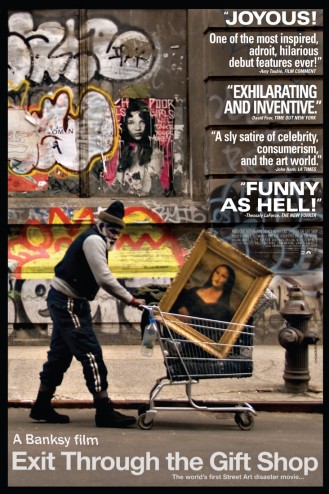
Exit Through the Gift Shop (one sheet)
The way this film was made was Banksy got all his street art buddies to supply him with video footage of themselves putting up their work (You think these guys aren’t documenting themselves? Street artists are many things but purists in it for the sake of “art” and art alone, they are not. Street art by its very nature is about self-promotion. Why do it if you can’t someday prove YOU did it?). Banksy got Shepard Fairey to come in with him. SF is clearly in on the MBW hoax (see SF’s website for the hype). A script was written. Theirry was cast, the film went into production and the centerpiece was the mounting of MBW’s Life Is Beautiful show in LA where some “actual” documentary interviews of the show’s attendees were shot and intermixed with some outrageous antics from TG and some real, some fake interviews of designers and assistants to MBW.
The film as a “movie story”
Before getting into the juicy specifics about TG, what we see of him and what we’re told about him in the film, let’s step back and look at the big picture, the forest if you will, the movie as a whole and the story it is telling us. ETTGS tells a very familiar Hollywood “movie” story, too familiar I’d say to be anything akin to a “documentary.”
ETTGS is a tightly scripted movie. In Blake Snyder’s book, Save the Cat! The Last Book on Screenwriting You’ll Ever Need, Snyder categorizes movies into ten basic plots (link). The “script” of ETTGS is a well crafted version of what Snyder calls “The Fool Triumphant” albeit with some clever, snarky, Banksy-esqe twists (I’ve seen other sources that call this type of script the “Visiting Angel” or the “Idiot Savant” story). Iin a nutshell to paraphrase Snyder:
This is the story of the Village Idiot. He’s the underdog, the overlooked, the ridiculous, and he’s set against an “establishment” bad guy. But they underestimate him, and because he’s The Fool, he’s got the forces of luck and good nature on his side. He may not fully understand what’s going on, but whatever his goal, he won’t give up – and the “establishment” doesn’t stand a chance.
Snyder goes on, “this sort of plot pokes fun at things we take too seriously.” Examples include Forrest Gump, Being There, Life Is Beautiful, etc. Like Forest Gump, the “idiot hero” of this type of story often succeeds “because of his idiocy” – a point ETTGS hammers home via the LA hoax. Also, crucial to this type of story is “a straight man “who is in on the joke and can’t believe the Fool is getting away with his ruse,” which leads to…
Banksy.
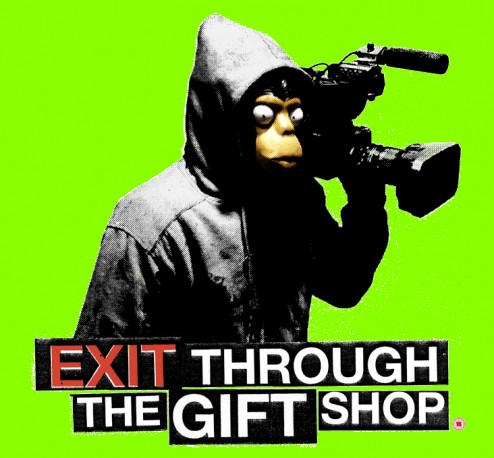
It’s Banksy!
In 2007, prices for his work exploded and his piece Space Girl & Bird sold at auction for $576,000. Banksy’s response was to create a picture of people bidding for a painting with an ornately gilded frame at an art auction; on the canvas were the words, “I can’t believe you morons actually buy this shit.” Shepard Fairey in an interview called ETTGS an extension of that sensibility.
As a graffiti artist and self-proclaimed vandal he’s a prankster through and through. Nothing with his name associated with it should be taken at face value. I wholly agree with Julian Sancton who wrote in Vanity Fair, “it would actually make less sense if he put out a movie that weren’t in some way pulling a fast one on the audience.”
Which brings us to the hoax. Mister Brainwash was dreamed up in the same spirit as the Emperor’s New Clothes. For the LA show Banksy footed the bill to hire a bunch of people to create the art (Juan Rodriguez posted an extensive comment at the bottom of this page detailing who made all the stuff and presented it all as work by MBW. Much of it skewers the top names in the art world, in effect defacing their images with stuff that looks like fake Banksys (Rodriguez doesn’t see any coherence among the work, yet in ETTGS the work we see adheres closely to Banksy’s basic approach suggesting that while there’s an overall mishmash of styles, Banksy had a hand in directing a large portion of the art makers, especially one Roman Lefeburte, whom Rodriguez says created the Warholian images). Art world stars who’s images are trashed include Damian Hirst, Jeff Koons, Takashi Murakami, and most especially Andy (Warhol). What’s more aggressive than the art is that MBW is being presented as someone akin to the big name guys his art is trashing. Just like them he has a large production team that makes the work. MBW claims that as an artist he does nothing but say, “that one ‘yes,’ that one ‘no.’” Banksy as always, gives himself the last word, “Most artists spend years perfecting their craft, developing their style, his stuff just looks a lot like everyone else’s.”
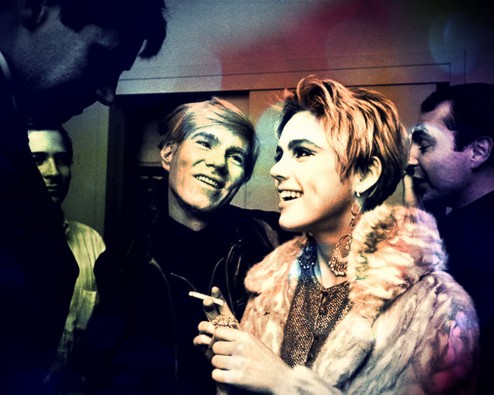
Andy Warhol and Edie Sedgwick (by unknown)
There are at least two things going on here, one is Banksy is making the case that he’s been busting his tail making his art. That’s a big part of what is on display with the footage of him and the other street artists working on roof tops at night doing what they do. In MBW, Banksy has created an “artist” who is an idiot. A guy who literally does nothing, puts on an enormous show with over 100 works on display and sells a million dollars worth of stuff that Banksy then gets to call trash.
The other thing going on is a bit more complicated and it has to do with Andy. Clearly Banksy has a love/hate relationship with Andy. His stencils are inarguably derived from Andy’s silk screens. Andy’s use of repetition is an essential part of all street art, but the crucial thing that Banksy derived from Andy was Warhol’s most inventive and significant creation – Andy Warhol. The persona Andy created was AW the artist as “village idiot.” A living, breathing blank: a machine. A mannequin in a wig without a single thought in his head. Take a look at the filmed interviews of Andy. See Painters Painting (now on DVD!) where Andy explains how he makes his art. As best as I can recall it goes something like this, “I take a picture from the paper and I give it to the man and he makes a screen and then I take it to the factory and there some people I know put it on a canvas for me.” “How do you pick your images?” “I don’t. I don’t have any ideas. I just ask other people to tell me what to do,” and on and on to hilarious effect. Banksy has taken it one step further and instead of being the artist as a completely empty man he’s the artist who doesn’t exist.
Banksy is selling work for ½ a mil. while Hirst and Koons and Murakami are overseeing large production teams who create their work which they then sell for millions. Hirst is apparently the most successful living artist with a purported net worth somewhere around $500,000,000. So, Banksy whose whole artistic agenda is to be anti-establishment and anti-capitalism is a tad ticked off. He’s blowing off some steam and laughing at us at the same time. But he’s clever enough to leave us thinking he’s not laughing at us but rather that he’s laughing at the poor suckers in LA who dished out the cash for the MBW paintings. Another thing he’s clever about is who to steal from and he couldn’t have done better than to lift from Warhol. The Campbell’s Tomato Spray Can (on the cover of the LA Weekly) is a real eye catcher as is the Marilyn wig (ripped off form SF via AW). The Andyness of those works makes us want to like them despite their awfulness. But Andy did something else that pertains here. One of the most beloved and oft-repeated of the many Andy stories is the one about the time he was booked to go on a speaking tour of college campuses and he decided he didn’t want to go so he sent a friend to go in his sted who pretend to be “Andy Warhol.” Which brings us back to where we started…
Thierry Guetta, aka MBW. Really!?
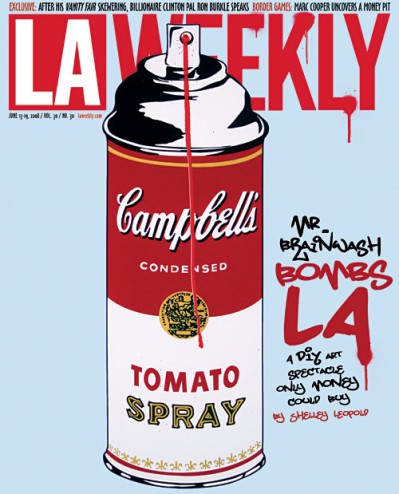
LA Weekly cover
Thierry Guetta is introduced to us as a guy who is “never without his video camera.” Really! The only other person I’ve ever heard of who was never w/o his (Polaroid) camera (and his tape recorder) was, well, Andy Warhol. The saccharine back story of how TG’s obsessive videoing is a Freudian reaction to the “trauma” of not being there when his mother died stinks of that cheesy Rockwellian schmaltz that hangs like dime store perfume around so many of Banksy’s images, and stunts. There’s a lame adolescent, class clown, wise-assness to it that’s of the stupid-funny variety that Hollywood keeps recycling for its #1 ticket buying demographic the 14 year old Alfred E. Neumans of the global economy.
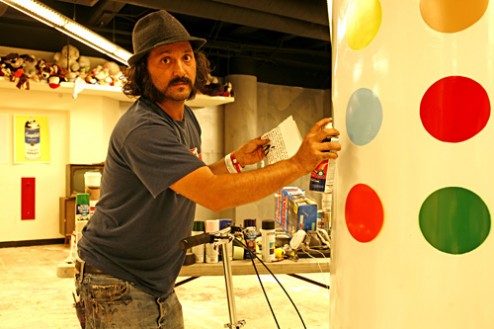
Thierry Guetta by Gregory Bojorquez
Next we learn that Thierry Guetta is the proprietor of some sort of thrift shop in LA. We see him standing in a small warehouse in front of random piles of clothes. This we are expected to accept is the source of his funds that pays for him to fly all over the world to video street artists and then later stage one of the largest independent art shows LA has ever seen. Really?! Then TG meets his cousin Space Invader who apparently welcomes his goofball cousin into his studio and out on his exploits. One street artist leads to another and before long TG hooks up with Sheppard Fairey who then introduces him to Banksy. Really!? Banksy apparently is so flattered that an idiot Frenchman from LA, w/no filmmaking experience, and a cheap consumer video camera, wants to interview him and video him doing his street art that he jumps at the opportunity. Banksy’s whole financial gambit is based on his retaining his anonymity. Top documentary filmmakers around the world surely would love to make a film about him, but we are to believe that Banksy has chosen to entrust his entire career, not to mention the secret to his identity, to the “village idiot.” Need I go on? Need we consider that we are asked to believe that Banksy is letting TG video him and then walk off with the tapes to do with them as he wishes? NOTE: This nice little bit brings up another sly Banksy-esque twist. We don’t immediately consider what Banksy is risking by letting TG video him because we’ve been privy to TG’s “big secret.” We’ve already seen the countless Tupperware containers stuffed w/unlabeled tapes and we know that all of TG’s footage ends up in TG’s “secret” black hole. NOTE to the NOTE: Banksy really plays us with this bit like a stand up comedian’s act playing on our universal queasiness over how we video our kids and then never go back and watch, much less edit, those tapes. Who among us knows what tape has that funny little shot of our little Jessica with that goofy Frenchman we saw putting up a poster of a rat? It must be in that pile of tapes somewhere, no?
The “art” in Banksy’s art comes from his knack for creating images and performing stunts that allow him to have it both ways. That’s what trompe l’œle is all about — making a brick wall look like there’s a hole in it or a rat climbing up it. ETTGS’ success rests solely on the Banksyness of its parts that have it both ways. The “LIB” show in LA is an art show w/o art and w/o an artist who made the art and yet it is a success on some level (or so we are led to believe). TG is not a documentary filmmaker and yet we end up watching a “documentary” that (some of ) we believe he made. Banksy and Sheppard Fairey endorse MBW and then call their own bluff.
Banksy flips this game on its head with TG’s presumed attempt to edit the footage, Life Remote Control, which Banksy dismisses as the product of an insane mind. The brief clip we see is actually quite startling for its slickness and craft (check it out again on YouTube). The sound design alone speaks of a professional’s touch and the dynamics of the visual assault editing technique hints at the same. Instead of the banality, of say an Andy Warhol film, LRC flickers like something from (Paul) Sharits or (Kenneth) Anger and other New American Cinema experiments from the late 60s that first seeped into cheapo AIP hippie “trip” films and European art/exploitation fare before being absorbed by MTV, Madison Ave. and select Hollywood feature title sequence makers. Banksy calls it inept and we’re asked to take him at his word despite what we see w/ our own eyes, we’re under his spell as he tells us what we see is not what we see – it’s a conceptual trompe l’œle. A Banksy.
What comes next requires a ginormous leap of faith. Banksy tells us he takes over the film from TG and advises/instructs him to go back to LA and “make some art.” Banksy deserves credit for getting away w/his ruse up to this point. A high percentage of viewers will not bother to question the validity of TG’s (highly unlikely) story up to this mid-point in the proceedings. TG’s transformation into Mister Brain Wash and the blooming of his Holy Fool persona to increasing comic effect start to raise credibility queries among many viewers, hence the proliferation of online rumors of a hoax. But let’s get back to following the plotline. Banksy is now making the film. (An analysis of “who’s” making the film from scene to scene leads us to another impressive way in which Banksy has been able to sustain having it both ways on a multitude of levels. Take for instance the sequence in which, I would guess most people read as being a part of the film that TG was making, we are introduced to Banksy by TG. We get a BBC-style “this is Banksy” thing where Banksy is glorified in all manner of ways as “the Man” in the world of street art. The pinnacle of the movement, it’s…well…it’s God if you will, which is pretty funny considering Banksy is making this film. It’s A Banksy Film that’s deifying Banksy as the greatest living street artist and will soon make the case for him as the greatest living artist by trashing both the opinion makers (those duped by MBW and the so-called greatest living artists, Hirst & Koons et. al.)
So TG goes back to LA, packs up the black hole of unlabeled, low-quality videotapes, rents a shipping container, ships his “life’s work” off to Banksy w/a nice note giving him his blessing to make of it whatever he wishes…(Oops, we skipped that part.) In any event whoever was making the movie at this point went to LA with TG (for God knows what reason?) and started to video him as he started to put up little rear window stickers of a Banksy-like image of himself with a camera (on cars we can only presume as the yucks broaden to slapstick proportions), and then large wheat pastes of said image all over LA. TG the street artist rises out of nowhere like a Sputnik and adapts the moniker Mister Brainwash. Really, Mr. Brainwash, MBW, really!? TG then rents out the 15,000 sq. foot, old CBS studio on West Sunset (in one of the most competitive urban real estate markets on the planet) and begins to prepare for his debut, the Life Is Beautiful show. NOTE: Remember $4 Puma sneakers resold to suckers for $40 is paying for all of this. ANOTHER NOTE: Story-wise there’s a problem with the sequence of events here. According to “the story” Banksy saw TG’s edit of the documentary, Life Remote Control, and decided he had to take over the film because TG has all this footage of the street artists and TG wasn’t capable (’cause he’s insane) of making a film out of it so Banksy had to step in and take it over. So why has a film crew gone to LA to film TG, to get some video of a crazy man?
Once TG becomes MBW and mounts “LIB” it might have made sense that Banksy would find him to have become interesting enough make a movie about but that was well after all that stuff we see of TG becoming MBW in LA. Well, you get the idea and can see that this is another contradiction that Banksy pushes on us via his on screen interviews where he plays the Monday morning quarterback to everything distracting us from the logic of the sequence of events. Banksy dismisses TG as a nutcase and at the same time has us believe that he sends a film crew to follow TG around LA because, who knows he may make something of himself some day. Maybe he’ll give street art a shot and prove anyone can do it. Maybe he’ll mount the biggest independent art show LA has ever seen since… well…Banksy.
The hoax itself is a thing of beauty. MBW, like the Emperor before him, gets to parade around naked w/everyone telling him how lovely his new clothes look. To quote the NY Times review, “‘He’s just kind of retarded,’ a worker on the Life Is Beautiful show says.” Banksy and Fairey ramp up the promotion (again at significant expense). Banksy and his team know the LA market. He mounted his own hugely successful show, Barley Legal in 2006, which, mind you, featured a video showing him pulling off a number of his stunts including the one at Disneyland (Oops! Wasn’t that footage supposed to be lost in TG’s black hole in 2006?!), and a flyer that read in part, “1.7 billion people have no access to clean drinking water. 20 billion people live below the poverty line. Every day hundreds of people are made to feel physically sick by morons at art shows telling them how bad the world is but never actually doing something about it. Anybody want a free glass of wine?”
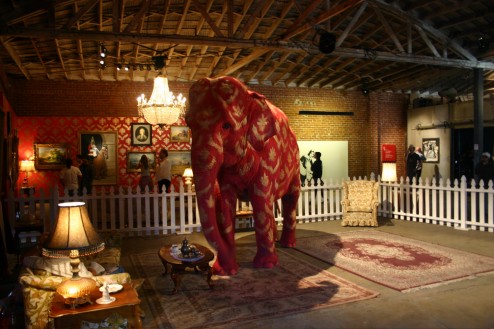
Barely Legal 2006 (from notcot.com)
The show also featured numbered prints for sale for $500 each, another contraBanksydiction as www.banksy.co.uk proudly proclaims, “Banksy does not endorse or profit from the sale of greeting cards, mugs, tshirts, photo canvases etc,” unless I guess if you go to his art show and buy one of his books or a $500 print or you have half a mil. to spend at auction.
The big coup was getting the LA Weekly cover story as it comes off in the film as “proof of legitimacy.” The story itself is not exactly “in-depth reportage” and raises but tosses aside questions about MBW’s authenticity, “there are questions about the validity of his art — which is most often compared to Banksy — and the way he’s inserting himself into the scene. What seems to temper these complaints is the fact that he hasn’t alienated the artists you’d think he’d be in competition with. Though he does confound them.” Really?! What does Banksy have to say? “Mr. Brainwash is a force of nature; he’s a phenomenon. And I don’t mean that in a good way.” Really?! NOTE that this is before LIB has even opened and Banksy is already quoting the tag line being used to promote ETTGS. The LAW article also noted that Banksy “is threatening to do a movie about the documentary Guetta never made” and that MBW’s show is being produced by Daniel Salin who also produced Banksy’s Barely Legal show. Salin gets off the real zinger when asked about the difference between the two shows he quips, “It’s like comparing apples and dirty socks.” Now that’s funny.
The central contradiction of course (where Banksy and Fairey really get to have their cake and eat it too) is in how they both support the LIB show via promoting the hell out of it (see SF’s website) and obviously also footing the bill for it and then being able to glibly call it trash. These are the big laughs in the film. Bansky’s delivery of the lines, “I used to encourage everyone to give street art a try…(long pregnant, beautifully timed pause)…I don’t do that so much anymore,” is the money shot of this whole endeavor (consider the satisfaction Banksy gets from staging the hoax of LIB and then getting to call it out as a crock. Really, really, consider that. Really!?)
NOTE: Big coup number 2 is MBW’s cover for the Madonna CD, but then again Banksy and Lady Vogue are about as far from strange bedfellows as two pop icons can get.
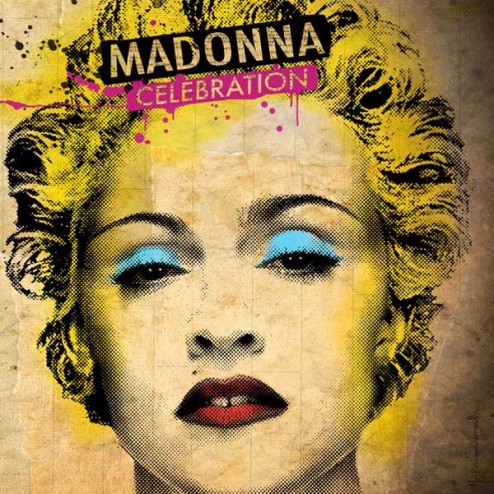
Madonna Celebration by Mr. Brainwash
FINAL NOTE on TG aka MBW: Neither Banksy nor TG (with one excellent exception here, have been made available to the press for interviews) When’s the last time you heard about a movie being released where the filmmaker and the star weren’t available for any publicity? They’re walking a thin line here and wisely stretching it out as far as it will take them.
ETTGS begins with a montage of images that spells out “Don’t buy this nonsense” (a nod to Orson Welles’ F for Fake). It ends with a sort of restaging of the ending of Alec Guinness’ Oscar-nominated 1958 film The Horse’s Mouth a satiric comedy about a Brilliant/Holy Fool of an artist who loves to paint feet and nothing but feet. He hoodwinks a wealthy art lover into commissioning a huge mural from him. Chock full of jabs at the art world and art lovers of all kinds and featuring an ending with bulldozers descending on the mural wall, The Horse’s Mouth is an ideological precursor and Banksy admirably pays it homage. The formal model, as has been widely noted, is Orson’s F for Fake.
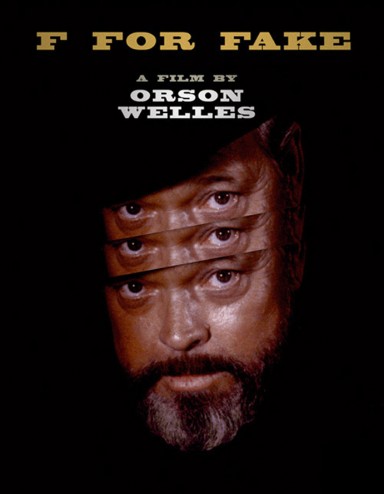
Orson Welles’ F For Fake (1973)
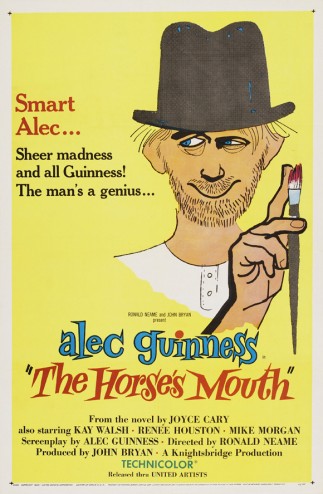
The Horse’s Mouth (1958)
Most all artists are disciples of their heroes. Banksy comes down to us from Andy. Andy went to school on Marcel (Duchamp), the man who signed a urinal “R. Mutt.” Exit Through the Gift Shop is a can of soup splashed on that pisser. It raises the bar among artist/filmmakers (Julian (Schnabel) watch yer back!) and there’s a temptation to call it just another hoax, but with the film now playing in 30-some theaters pleasing critics and audiences alike and nothing more than rumors that MBW may not be what he seem, this Banksy is proving to be the real thing.
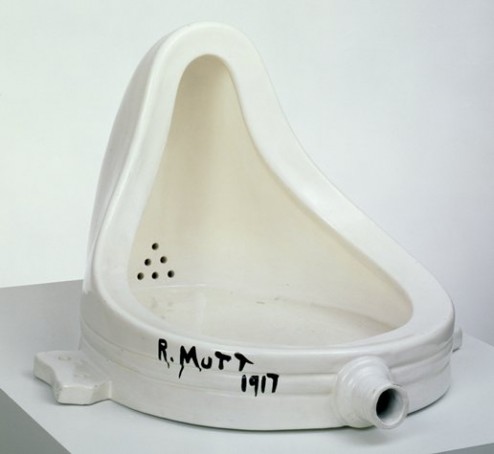
Marcel Duchamp, Fountain, 1917-1964, © Artists Rights Society (ARS)

Exit Through the Gift Shop (alternate one sheet)

